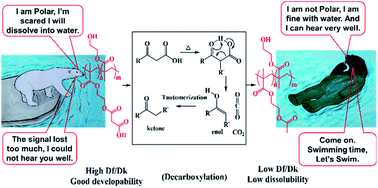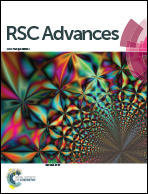Application of decarboxylation reactions for improvement of dielectric properties of a methacrylic polymer†
Abstract
In this work, we present a method based on thermally induced decarboxylation to solve the incompatibility of dielectric properties and the developability in aqueous developer solution of dielectric materials for the application in photodefinable insulating materials. Herein, malonic acid 2-hydroxyethyl methacrylate monoester, a methacrylate monomer with β-keto acid is synthesized via phosphotungstic acid catalyzed esterification of 2-hydroxyethyl methacrylate and malonic acid. Further polymerisation is conducted with the obtained monomer to prepare poly(2-hydroxyethyl methacrylate-co-malonic acid 2-hydroxyethyl acrylate monoester). The thermally induced decarboxylation behaviors of the prepared polymer are confirmed with TGA, pyrolysis-GCMS analysis, and IR analysis. Df/Dk tests and dissolution tests are carried out to investigate the influences of decarboxylation on the dielectric properties and dissolubility in aqueous solution, respectively. The results demonstrate that the significant changes in dielectric properties and dissolubility are due to the thermally induced decarboxylation.



 Please wait while we load your content...
Please wait while we load your content...